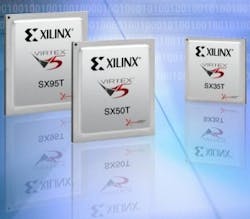Today's FPGA trends in aerospace and defense applications involve security, tools, and specialization
Information security, advanced FPGA programming tools, and increasing specialization for an ever-broadening number of potential applications are primary trends in today's field-programmable gate array (FPGA) technology for aerospace and defense. FPGA's represent one kind of programmable digital processor with many gates that enable systems designers to custom-program the device on the fly for security, functionality, power consumption, and other benefits.
"One of the most important trends coming up now is security," explains Young Kwon, product marketing manager for aerospace and defense at FPGA specialist Xilinx Inc. in San Jose, Calif. We have two different kinds of security: information assurance, which is cryptography and keeping adversaries from decoding what you are saying; and anti-tamper, which comes into play when you want to prevent an adversary from reverse-engineering a piece of equipment."
Xilinx officials pride themselves on the ability of their company's FPGA devices to support on-board cryptography. "We have a unique way that reduces the number of pieces of hardware you need to implement it," Kwon explains. "We have single-chip cryptography where we can do many of these functions in one piece of silicon. We released that capability first in our Virtex 4 FPGAs."
Xilinx also considers itself a leader in anti-tamper technology, which can prevent an adversary from reverse-engineering FPGAs to learn about the capabilities they contain. A Xilinx FPGA with anti-tamper capability "in general will destroy itself, or least destroy the information it contains" in case of an unauthorized attempt to reverse-engineer the device. Reverse engineering essentially seeks to take a device apart to learn its secrets.
Anti-tamper capability is key for today's complex military applications, such as smart munitions, which contain intellectual property that enables U.S. defense capability to stay ahead of those of potentially hostile nations and terrorist organizations.
Where FPGA programming tools are concerned, some of today's most notable technology trends involve helping systems designers comply with the DO-254 standard for assuring quality and safety for airborne electronic hardware for commercial aviation.
"There is an increasing awareness and desire to comply with DO-254, which requires assistance from the tools vendors," says Ken O'Neill, director of marketing for the Space Products Team at the Microsemi SoC Group (formerly Actel) in Mountain View, Calif. "Compliance with DO-254 requires assistance from the FPGA tools vendors because there are requirements to provided documentation and traceability. The tools vendors have been doing a lot to provide easier and more comprehensive ways to ensure that compliance."
In addition, O'Neill says, FPGA tools vendors also are helping device manufacturers with difficult problems like providing triple redundancy for dealing with radiation-induced single-event upsets (SEUs) in space applications. "A synthesis tool that takes care of that redundancy for you is a handy thing to have," he says.
Among the FPGA tools vendors that are helping device manufacturers with DO-254 compliance, O'Neill singles out Mentor Graphics in Wilsonville, Ore., and Aldec Inc. in Henderson, Nev. Among the tools providers helping with tasks like triple redundancy, O'Neill Sites Mentor Graphics and Synopsys Inc. in Mountain View, Calif.
Perhaps most significant of today's trends in FPGAs is the breadth of aerospace and defense applications that these devices enable. "There is greater specialization in FPGAs today, with a greater variety of features in our products and those from other vendors," O'Neill says.
"If you survey the market, you see FPGAs based on DSP [digital signal processing] applications, and different ranges of devices with on-board microprocessors to meet needs for general-purpose processing," O'Neill says. "Some integrate well with the analog world, and some are optimized to minimize power consumption. We see that level of specialization increasing as time moves on."
Embedded computing specialist Mercury Computer Systems Inc. in Chelmsford, Mass., is making a move into electronic warfare and signals intelligence applications, and its engineers find that today's FPGAs -- particularly from Xilinx -- "are very good at the processing that has to happen to deal with the radio frequency spectrum," explains Tom Roberts, solutions marketing manager at Mercury.
"For the counter-IED [counter-improvised explosive device] implementations we have worked on, receiving a signal, understanding its components, and enabling the exciter to understand what kind of frequency it needs -- all really fast and highly parallel -- is all done in the FPGA on XMC cards," says Anne Mascarin, another solutions marketing manager at Mercury.
Field-programmable gate array (FPGA) technology suppliers
FPGA devices
Achronix Semiconductor Corp.; San Jose, Calif.; 408-889-4100; www.achronix.com
Altera Corp.; San Jose, Calif.; 408-544-7000; www.altera.com
Anadigm Inc.; Campbell, Calif.; 480-422-0191; www.anadigm.com
Atmel Corp.; San Jose, Calif.; 408-441-0311; www.atmel.com
BEEcube Inc.; Fremont, Calif.; 510-252-1136; http://beecube.com
Celoxica Ltd.; Abingdon, England; +44 (0) 1235 863656; www.celoxica.com
Lattice Semiconductor Corp.; Hillsboro, Ore.; 503-268 8000; www.latticesemi.com
Microsemi SoC Group (formerly Actel); Mountain View, Calif.; 650-318-4200; www.actel.com
QuickLogic Corp.; Sunnyvale, Calif.; 408-990-4000; www.quicklogic.com
Tekmos Inc.; Austin, Texas; 512-342-9871; www.tekmos.com
Xilinx Inc.; San Jose, Calif.; 408-559-7778; www.xilinx.com
FPGA boards
Acromag Inc.; Wixom, Mich.; 877-295-7092; www.acromag.com
BittWare Inc.; Concord, N.H.; 603-226-0404; www.bittware.com
Connect Tech Inc.; Guelph, Ontario; 519-836-1291; www.connecttech.com
Curtiss-Wright Controls Embedded Computing; Ashburn, Va.; 703-779-7800; www.cwcembedded.com
DLP Design Inc.; Allen, Texas; 469-964-8027; www.dlpdesign.com
GE Intelligent Platforms; Charlottesville, Va.; 434-978-5000; www.ge-ip.com
Jacyl Technology; Fort Wayne, Ind.; 260-471-6067; www.jacyltechnology.com
Kontron AG; Poway, Calif.; 888-294-4558; www.kontron.com
Lyrtech; Quebec City; 418-877-4644; www.lyrtech.com
Mercury Computer Systems Inc.; Chelmsford, Mass.; 866-627-6951; www.mc.com
Nallatech Inc.; Eldersburg, Md.; 805-383-8994; www.nallatech.com
Opal Kelly Inc.; Portland, Ore.; 217-391-3724; www.opalkelly.com
Orange Tree Technologies Ltd.; Didcot, England; +44 1235 838646; www.orangetreetech.com
Pentek Inc.; Upper Saddle River, N.J.; 201-818-5904; www.pentek.com
Presco Inc.; Woodbridge, Conn.; 203-389-1129; www.prescoinc.com
TEK Microsystems Inc.; Chelmsford, Mass.; 978-244-9200; www.tekmicro.com
Themis Computer; Fremont, Calif.; 510-252-0870; www.themis.com
Welkin Sciences LLC; Colorado Springs, Colo.; 719-520-5115; www.welkinsciences.com
FPGA intellectual property
Elliptic Technologies Inc.; Ottawa; 613 254-5456; www.elliptictech.com
Inicore Inc.; Newark, Calif.; 510 445 1529; www.inicore.com
The MathWorks; Natick, Mass.; 508-647-7001; www.mathworks.com
National Instruments; Austin, Texas; 800-531-5066; www.ni.com
S2C Inc.; San Jose, Calif.; 408-213-8818; www.s2cinc.com
